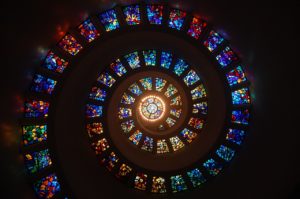A QUESTION which should be asked before many others of the art of any age (but people are too often shy of putting prosaic questions to something so sublime as art) runs: what is the position of the artist in society and for people of what position does he work? In our age of supreme individualistic emancipation, in which the organic community is rather something for which the artist passionately longs than a reality, and in which the artist has more or less to depend on himself, the question is certainly not such an important one, though it is still often dismissed too casually.This is, therefore, particularly true of the so-called primitive peoples. The sociological way of thinking is comparatively rarely employed by the history of art, but it is no accident that ethnology is quite used to it, even when discussing the products of art.
The very use of the word ‘art’ in this connexion is already, however, a partial and premature answering of the question, as it seems to imply that there is such a thing as a recognized artistic genius in primitive society. That is quite certainly not the case in the early stages. Nevertheless we shall retain the word, using it to mean no more than a creator of objects which we recognize as works of art — even if only from our modern point of view. This formulation must also contain the further reservation that the works of art were not at first produced as works of art but as objects having some particular utilitarian value, and one cannot ascribe an aesthetic intention either to the maker or to the customer.
African history means primarily immigrant movements, migrations of peoples on the very largest scale, the overlaying of cultures by other cultures. It means, too, that states grew up and disappeared again, that dynasties prospered and fell, and that there came battles, wars and the making and breaking of peace. But all this historical event has not culminated in the way familiar to us in high cultures such as the Asiatic, Old American or European. If one excepts Egypt it was only by fits and starts that cultural patterns comparable with those were produced; the most famous would be that of the Kingdom of Benin in the Niger region. (It is no accident that it was the discovery of this kingdom in the nineties of the last century that gave the greatest impetus to the serious study of African cultures and to the emancipation from the prejudices of our civilization towards the Negroes.) All the same these high-culture systems lie far in the past and have either not carried over into this century or have done so only in the most meagre way. They have one and all gone under, of their own weakness or through the devastating influence of other continents, and are vanished beyond recall. Thus the vast historical continent called Africa is today covered with the wounds and scars of desperate and, in the long run, ravaged growth.
In one essential respect, however, Africa presents itself as wholly without history, and that is in its monumental passivity. Nearly all its historical impetuses have been received from without. In wave upon wave the foreign immigrations and revolutions passed across it, coming mainly from the Asiatic region. Where Africa itself developed a history this occurred, so to speak, in a circle, without achieving in any permanent sense a higher historical pattern. Such a pattern was brought about only by stimuli from without. If indeed one disregards Islam and the graftings from European civilization, then one finds that Africa has always made something absolutely African out of all external influences, thus showing, despite its passive and receptive attitude, all its inner strength. A classical example of this may be found in the art of Benin itself, unthinkable without the strongest external influences and yet revealing such a special character that it is impossible to point to clear connexions with other cultures, and that a desperate attempt has been made to describe the sunken continent of Atlantis as the cradle of this culture.
Africa is the land of the African Negroes, with the limitation that we distinguish from them the preceding nonNegro hunting and collecting cultures, and thus with the further limitation that in their myths, and therefore also in certain art forms, there still lives a memory of the original inhabitants of the country who were supplanted by them.
There are no dates associated with most of the objects in the Art and Life in Africa program because the African artists who created them neither signed their names nor dated the objects. (It should be noted that many European artists of the Middle Ages and early Renaissance did not sign or date their work either.) Because most African art is made of wood, and wood does not usually last long in harsh African environments, most of the wooden objects in the program probably date from the late 19th or early 20th century. Even this much is based on guesswork, and as a result, we have chosen not to list the dates repeatedly as “late 19th or early 20th century.”
There is, however, a very important exception: the objects in the “Ancient Africa” section are for the most part made of fired clay, bronze, gold, or other very durable materials that have not only survived the centuries, but have been found in an archeological context or associated with archaeological sites. Therefore, we have dates that can be attributed to these objects. The “Ancient Africa” chapter was intended to provide some of the historical or chronological depth that is missing elsewhere due to the lack of dates. The chapter was written expressly to make it clear that African art has been created for millennia, and that many of the objects in the world’s museums are indeed ancient.
Examples of some of the oldest objects are from the so-called Nok culture, which have been roughly dated from 500 BC to 200 AD. The very elaborate and important objects from Igbo-Ukwu, in eastern Nigeria, have been dated by the archaeologist Thurston Shaw to the 9th or 10th century AD. The ancient Djenn* culture on the Niger River in Mali has been dated from about 500 to 1400 AD, although most of the objects in museums have not been found by archaeologists, and so dating the objects themselves is problematic. The naturalistic memorial heads of deceased kings of Ife are dated to the middle of the 13th century by archaeologists. Finally, Professor William Dewey, who wrote the “Ancient Africa” chapter, provides a series of dates, from the 5th to the 19th century, for the material from the Benin Kingdom in Nigeria.
In order to arouse public interest in the Congo Free State King Leopold II had a major exhibition organised in 1897 on the country and its importance for Belgium. From 1898 onwards the scientific mission of the Museum became its main task and because of t he rapid growth of scientific collections from Central Africa the need for a new and bigger building was felt very soon.
In order to arouse public interest in the Congo Free State King Leopold II had a major exhibition organised in 1897 on the country and its importance for Belgium. From 1898 onwards the scientific mission of the Museum became its main task and because of t he rapid growth of scientific collections from Central Africa the need for a new and bigger building was felt very soon.
African Art: Aesthetics and Meaning. This electronic exhibition catalog contains a number of photographs from the Bayly Art Museum’s recent exhibition of African art. Related materials to be offered in the future include an exhibition of African masks.
Submitted by:Michael SanfordFor more information on african american art please visit the african american art resource center at http://www.african-art-guide.info.info |





